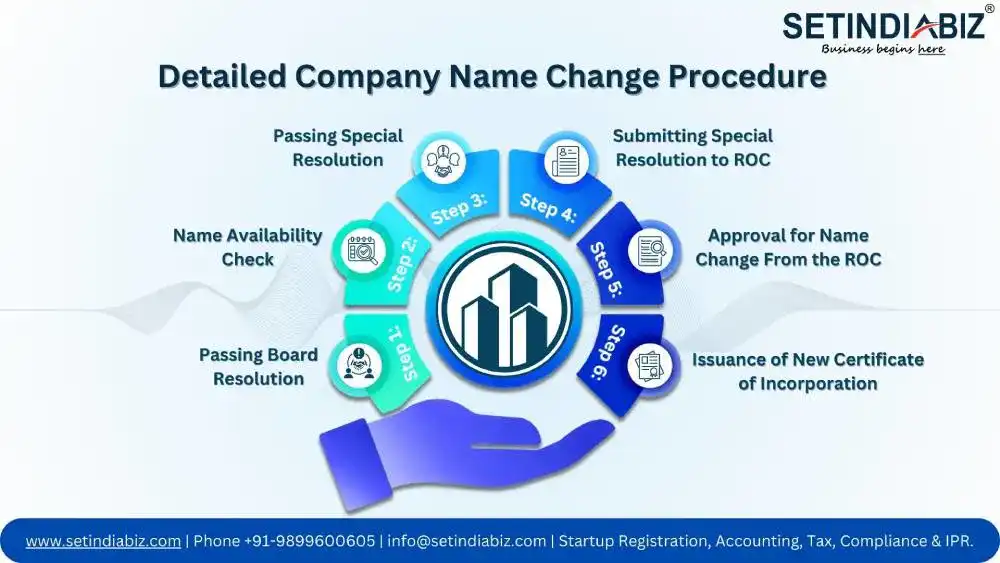Company Name Change Procedure
Overview : Changing a company’s name is a significant decision that requires careful consideration and adherence to legal procedures. In this blog, we’ll delve into the procedure, documentation, timeline, company name change fees and the common reasons why companies must opt for a name change in the first place! Understanding the procedure and reasons to change company names is essential for businesses, as it ensures a smooth transition of identity and maintenance of legal compliance.
A company may opt to change its name for various strategic reasons. One common motive is to align the company’s branding with its evolving business objectives, reflecting changes in its products, services, or target market. Additionally, a name change might be necessitated by a merger, acquisition, or restructuring, signaling a shift in ownership or corporate identity as well.
A name change can serve crucial legal purposes, such as avoiding trademark conflicts or complying with regulatory directives as well. Whatever the reason, changing a company’s name can be a proactive step toward revitalizing its image, strengthening its market presence, and adapting to changing business dynamics. Let’s understand the crucial requirements and process of doing so.
Why is Changing a Company’s Name Important?
Changing a company’s name is a strategic decision often driven by various factors that reflect its evolving business landscape and goals. Understanding these underlying reasons is crucial for stakeholders to comprehend the rationale behind such a significant alteration. From repositioning the brand to complying with regulatory requirements, each motive sheds light on the dynamic nature of modern businesses and their need to adapt to changing market dynamics and consumer preferences. The list below explores key reasons for changing a company’s name.
- Evolution & Expansion of Business: As companies evolve and expand their operations, they may find their existing name limiting in capturing the full scope of their activities. For instance, a technology startup initially focused on software development may later diversify into hardware manufacturing or cloud services. In such cases, a name change becomes imperative to reflect the broader spectrum of the company’s offerings and market positioning.
- Brand Repositioning and Image Enhancement: Companies may opt for a name change as part of a broader strategy to reposition their brand and enhance their market image. For example, a company with a name associated with outdated technology or practices may choose to rebrand itself with a more contemporary and forward-thinking identity to appeal to modern consumers and investors.
- Mergers, Acquisitions, and Strategic Partnerships: Mergers, acquisitions, and strategic partnerships often necessitate a name change to reflect the new ownership structure or to create a unified brand identity. For instance, when two companies merge, they may consolidate under a new name that symbolizes their combined strengths and shared vision, facilitating integration and fostering a sense of unity among stakeholders.
- Legal Compliance and Intellectual Property Protection: Legal considerations, including trademark conflicts, copyright issues, and regulatory directives, can compel companies to change their names. For example, if a company discovers that its existing name infringes on another entity’s trademark rights, it may opt for a name change to avoid litigation and protect its brand reputation.
- Cultural Sensitivity and Global Expansion: In an increasingly interconnected world, companies expanding into new markets must consider cultural nuances and linguistic meanings associated with their brand names. A name that resonates positively in one region may have negative connotations in another. Therefore, companies may choose to rebrand themselves with culturally neutral or universally appealing names to facilitate global expansion and cross-cultural communication.
Guidelines & Principles to Change Company Name
The Ministry of Corporate Affairs (MCA) in India provides clear guidelines to change company names and select a new one. These guidelines aim to ensure that the new name chosen is unique, compliant with legal requirements, and does not infringe upon existing trademarks or cause confusion among stakeholders. Understanding these guidelines is essential for companies undertaking a name change to avoid rejection of their application by the Registrar of Companies (RoC) and expedite the approval process.
- Unique and Distinctive Name: According to MCA guidelines, the new name chosen by a company must be unique and distinctive, distinguishing it from existing company names and trademarks. The name should not be identical or deceptively similar to the names of other registered companies or trademarks to prevent confusion among consumers and investors. Conducting a thorough search of existing company names and trademarks through the MCA portal or professional services is recommended to ensure the proposed name’s uniqueness.
- Compliance with the Companies Act, 2013: The chosen name must comply with the provisions of the Companies Act, 2013, and other relevant regulations prescribed by the MCA. This includes avoiding the use of prohibited words or phrases listed in the Companies (Incorporation) Rules, 2014, and ensuring that the name reflects the company’s business activities and objectives accurately. Additionally, the name should not imply any illegal or offensive activities or contravene public policy or morality.
- Prohibition of Names under the Names and Emblems Act: Companies must ensure that the proposed name does not violate the provisions of the Names and Emblems (Prevention of Improper Use) Act, 1950, and its associated rules and regulations. This legislation prohibits the use of certain names, emblems, and symbols that are reserved for exclusive use by the government or have national significance. Therefore, companies must conduct thorough research to avoid proposing names that incorporate prohibited words, symbols, or phrases listed under the Names and Emblems Act to prevent potential legal complications and ensure compliance with statutory requirements.
- Reservation of Name through RUN Facility: To streamline the process of selecting a new name, the MCA offers the Reserve Unique Name (RUN) facility, allowing companies to reserve a proposed name for up to 20 days. Companies can submit up to two proposed names through the online portal and receive instant feedback on the availability and suitability of the names. This enables companies to make an informed decision when selecting a new name and reduces the risk of rejection by the RoC.
Detailed Company Name Change Procedure
The company name change procedure requires careful planning, adherence to legal requirements, and effective coordination with regulatory authorities. It involves several steps to ensure a smooth transition of identity and adherence to legal compliance. Understanding the intricacies of the name change process is essential for companies to minimize disruptions to their operations and safeguard their brand reputation.

Step 1: Passing Board Resolution
The process of changing a company’s name typically begins with the approval of a board resolution. The board of directors convenes a meeting to discuss and approve the decision to change the company’s name, outlining the reasons for the change and authorizing the necessary actions to be taken.
Step 2: Name Availability Check
Following the board resolution, the company must conduct a name availability check to ensure that the proposed name is unique and not already registered by another entity. This can be done through the Reserve Unique Name (RUN) facility of the Ministry of Corporate Affairs (MCA) portal, where companies can reserve a proposed name for up to 20 days.
Step 3: Passing Special Resolution
Once the availability of the proposed name is confirmed, the company convenes an Extraordinary General Meeting (EGM) to pass a special resolution approving the name change. The resolution must be passed by the requisite majority of shareholders as per the provisions of the Companies Act, 2013.
Step 4: Submitting Special Resolution to ROC
Following the EGM, the company must file various forms and documents with the Registrar of Companies (RoC) to formalize the name change process. Form MGT-14 is filed with the RoC within 30 days of passing the special resolution, along with certified copies of the special resolution and altered Memorandum of Association (MOA) and Articles of Association (AOA).
Step 5: Approval for Name Change From the ROC
Additionally, Form INC-24 is filed with the RoC to obtain approval from the central government for the name change. This form is accompanied by certified copies of the minutes of the EGM, notice of the EGM, resolution agreement, altered MOA and AOA with the new company name, and any other optional attachments as required.
Step 6: Issuance of New Certificate of Incorporation
Upon receipt of all necessary documents and approvals, the RoC issues a new certificate of incorporation reflecting the updated company name. The name change process is considered complete only after the issuance of the new certificate of incorporation by the RoC.
Documents Required to Change Company Name
| S.No. | Conditions of Ineligibility for filing ITR-U |
|---|---|
| Document | Purpose |
| Board Resolution | Resolution passed by the board of directors approving the change of company name. |
| Special Resolution | Resolution passed by shareholders in an Extraordinary General Meeting (EGM) approving the name change. |
| Altered Memorandum of Association (MOA) | Updated MOA reflecting the new company name and any changes to the company’s objects and activities. |
| Altered Articles of Association (AOA) | Updated AOA reflecting the new company name and any changes to the company’s internal regulations. |
| Certified Copy of Special Resolution | Copy of the special resolution passed in the EGM, certified by a director or company secretary. |
| Notice of EGM | Notice convening the EGM to pass the special resolution for the name change. |
| Minutes of EGM | Minutes of the EGM where the special resolution was passed, certified by the chairman of the meeting. |
| Resolution Agreement | Document detailing the members voting for and against the resolution, along with their shareholding. |
| Approval Order from Authorities (if any) | Copy of approval order received from authorities such as SEBI, IRDA, RBI, etc., if applicable. |
| Certificate of Incorporation | Certificate of incorporation reflecting the existing company name. |
| List of Shareholders and Directors | List of shareholders and directors updated to reflect changes resulting from the name change. |
| Digital Signature of the Authorised Director | Digital signature of the authorized director used for filing documents with the RoC. |
| Proof of Registered Business Address | Document confirming the registered business address of the company, such as utility bills or lease agreements. |
Company Name Change Fees & Timeline
The company name change procedure involves various factors affecting its fees to ensure a smooth transition of identity. These typically include government fees for new name approval, filing forms with the Registrar of Companies (RoC), acquiring DSC, professional fees for legal consultation, and potential expenses for updating company stationery like letterheads and billboards.
The exact company name change fees may vary depending on the availability of the proposed name, the company’s size, and the extent of professional assistance required. However, the uniform government fees of name approval and ROC filings have been mentioned below.
- New Name Approval Application: Rs.1,000
- ROC Filings: Rs.600
As far as the timeline is concerned, the company name change process in India typically spans several weeks to months, depending on various factors such as the availability of proposed names, the scheduling of board and shareholder meetings, and the processing time of government authorities.
From the initial decision to change the name to obtaining the updated certificate of incorporation reflecting the new name, companies should anticipate a timeline of approximately 10 to 15 working days for completing the procedural formalities with the RoC. However, the actual duration may vary based on the efficiency of document preparation, submission, and processing, as well as any potential delays caused by regulatory reviews or legal considerations.
Activities After Company Name Change
Following the successful completion of the company name change procedure, several essential activities need to be undertaken to ensure operational continuity and compliance with legal requirements. These activities encompass updating internal and external documents, notifying stakeholders, and aligning branding elements with the new company name.
Internally, companies must update their Memorandum of Association (MOA) and Articles of Association (AOA) to reflect the new name officially. Additionally, changes to bank accounts, statutory registers, employment contracts, and business licenses or permits should be initiated promptly to reflect the updated company name accurately.
Externally, companies must communicate the name change to various stakeholders, including clients, suppliers, regulatory authorities, and the general public. This may involve issuing press releases, updating the company website and social media profiles, and revising marketing materials such as business cards, letterheads, and advertisements.
Furthermore, companies should update their company seal, official stamps, and any other branding elements to ensure consistency with the new name across all platforms. By proactively addressing these post-name change activities, companies can minimize disruptions to their operations and maintain trust and credibility among stakeholders in the aftermath of the rebranding initiative.
Activities After Company Name Change
Company name change is a significant endeavor involving strategic planning, right execution, and adherence to legal and regulatory requirements. By exploring the underlying reasons for such change, navigating the procedural formalities with diligence, and addressing post-name change activities promptly, companies can successfully reposition their brand, enhance their market visibility, and adapt to evolving business dynamics. With careful consideration and effective communication, a well-executed name change can pave the way for continued growth, innovation, and success in the competitive business era.
FAQ's
1.Can any name be chosen for the company?
2.How long does it take to change a company's name?
3.Do I need shareholder approval to change the company's name?
4.What documents are required for a company name change?
5.Are there any additional steps to take after the company name change procedure?
Author Bio

Editorial Team | in
Setindiabiz Editorial Team is a multidisciplinary collective of Chartered Accountants, Company Secretaries, and Advocates offering authoritative insights on India’s regulatory and business landscape. With decades of experience in compliance, taxation, and advisory, they empower entrepreneurs and enterprises to make informed decisions.
